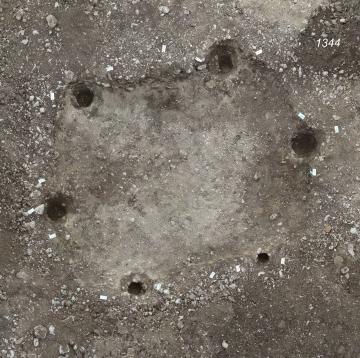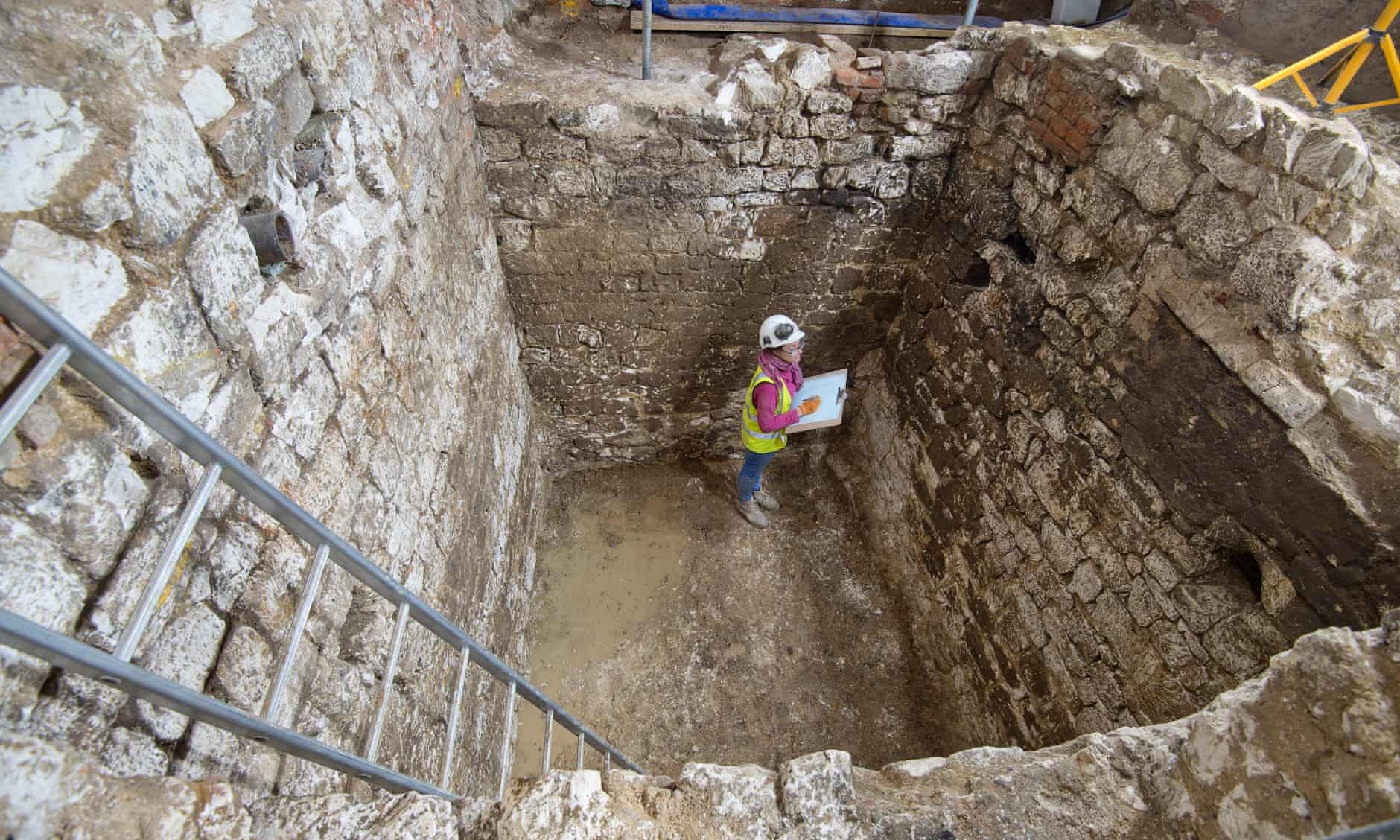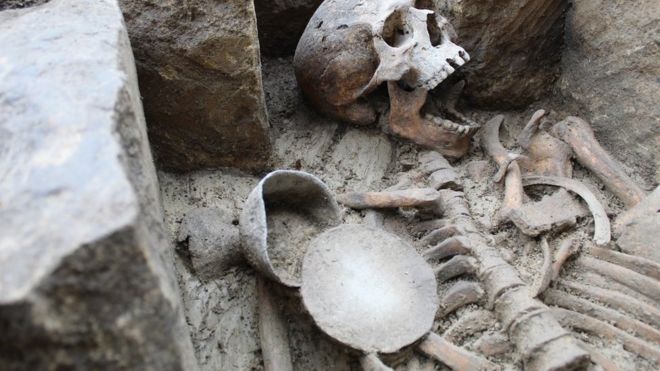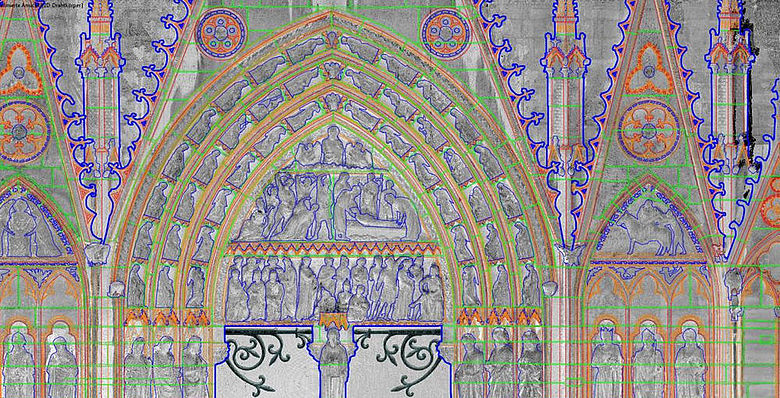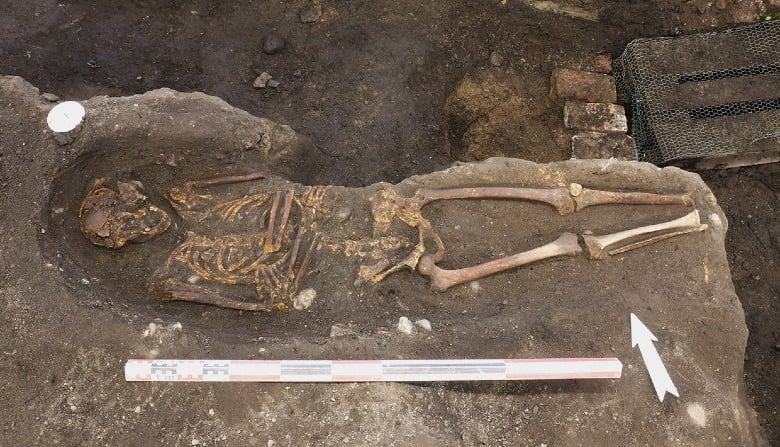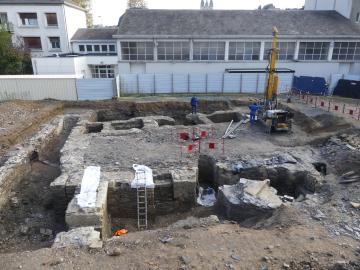Archaeological news about the Archaeology of Later Medieval Europe from the Archaeology in Europe web site
Wednesday 29 January 2020
UN SITE DU HAUT MOYEN ÂGE ET UNE OCCUPATION MÉSOLITHIQUE À PONTARLIER
À Pontarlier (Doubs), l'Inrap a mené une fouille archéologique préventive sur le site des Gravilliers, dans le cadre de l'aménagement d'un parc d'activités économiques du Grand Pontarlier. Un diagnostic archéologique réalisé en 2011 avait déjà révélé un site du premier Moyen Âge et une occupation mésolithique (9600 à 5500 ans avant notre ère) qui avait livré les plus anciens indices d'occupation humaine connus à Pontarlier. Une première fouille, en 2015, avait amplement confirmé les résultats du diagnostic.
L’une des particularités du site moyenâgeux des Gravilliers est de se situer en totalité dans l’emprise du projet d’aménagement, permettant une vision exhaustive de l’ensemble, fait exceptionnel dans le cadre de fouilles préventives. La portée scientifique des recherches effectuées sur le site est considérable pour la compréhension de la dynamique de l'habitat rural médiéval et devrait constituer une référence pour l'est de la Gaule. Les résultats de la fouille seront précisés lors de la phase d'étude en 2020-2021.
Read the rest of this article...
Monday 27 January 2020
Newport Ship could be Wales' answer to the Mary Rose
The ship would have been moored in an inlet on the River Usk in Newport at around 1468
NEWPORT MUSEUMS AND HERITAGE SERVICE
Archaeologists say "there's nothing else like" the medieval ship, the remains of which were found preserved in mud in a Newport riverbank in 2002.
Historians say reassembly of the 2,500 timber pieces will be the world's largest ancient ship rebuild project.
Newport council said it hopes to display the ship in a prominent place.
Experts say the "unique" attraction could emulate the Mary Rose exhibition of Tudor king Henry VIII's 16th Century flagship naval vessel, renowned as one of the world's best maritime displays with its own £35m museum,
Read the rest of this article...
Medieval treasures uncovered – from the sludge of a London cesspit
A Mola archaeologist records the medieval cesspit uncovered in
the basement of the Courtauld.
Photograph: Mola
Forks, pendants and wine jugs shine a light on city life in the Middle Ages
It is said that one person’s trash is another’s treasure. The discovery by archaeologists of a huge cesspit containing medieval artefacts under one of London’s finest historic buildings is proving the case.
Up to 100 objects, largely dating from the 14th and 15th centuries, have been retrieved from sticky, greenish sludge in a four-metre-deep pit beneath the Courtauld Institute of Art at Somerset House.
The haul includes pottery drinking vessels and tableware, along with a rare Penn floor tile – a favoured decorating material for palaces and monastic sites – and a range of metalwork pieces, including an iron spur, a finger ring, a belt buckle, a bone-handled fork and a pendant. There is also a thick chain, which might once have been attached to a candlestick. Although discarded, many of these objects are virtually intact.
Read the rest of this article...
Friday 24 January 2020
Lincoln Cathedral: Medieval priest's items 'rare find'
The priest was buried alongside a pewter chalice and paten, which is a plate made of gold or silver
Image copyrightALLEN ARCHAEOLOGY
The find was one of more than 50 burials unearthed during renovation works at Lincoln Cathedral.
Archaeologist Natasha Powers said the priest was buried with a pewter chalice and paten - a gold or silver plate.
He believed his tools would provide proof on Judgement Day that he had performed his duties, she said.
Ms Powers said since work started in 2016 they had discovered "significant evidence" of Lincoln's medieval, Saxon and Roman past.
Read the rest of this article...
Sunday 19 January 2020
Treasure trove of medieval history rises from the ashes of Notre Dame
The fire last April exposed parts of the building that have never been studied
GEOFFROY VAN DER HASSELT/GETTY IMAGES
Nine months after it was engulfed in a fire that shocked the world, the cathedral of Notre Dame in Paris has become a “gigantic laboratory for archaeology.”
More than 100 researchers, including archaeologists, engineers, historians and chemists, have started a lengthy study of the medieval structure and thousands of pieces of charred debris.
Their goal is to unravel secrets not only of the cathedral’s construction in the 12th-14th centuries but also the earlier buildings on the site and gothic architecture more widely. The multimillion-euro joint project by the French national research organisation CNRS and the Ministry of Culture will go on for six years, but initial findings are already rewriting the cathedral’s story.
Read the rest of this article...
Wednesday 15 January 2020
Notre Dame in Paris: 3D-Daten für den Wiederaufbau
Ausschnitt des Südportals am Querhaus der Kathedrale von Notre Dame als CAD-Umzeichnung. Quelle: Angel Menargues/Ruth Tenschert/Universität Bamberg
Die Otto-Friedrich-Universität Bamberg, die französische Forschungsorganisation »Centre national de la recherche scientifique« (CNRS) und das französische Ministerium für Kultur haben einen Vertrag über die Beteiligung der Bamberger Kunstgeschichte in der Initiative »Chantier Notre-Dame« unterzeichnet. In dieser Initiative bringt das CNRS Expertinnen und Experten aus verschiedenen Fachbereichen zusammen, um eine wissenschaftliche Grundlage für den Wiederaufbau der Kathedrale Notre Dame zu schaffen. Das Wahrzeichen von Paris war am 15. April 2019 in Brand geraten und teilweise zerstört worden.
Read the rest of this article...
Monday 13 January 2020
Unexpected Cemetery Found in Central Trondheim
One of the fourteen individual graves. Photo: NIKU
During the archaeological excavations in Kjøpmannsgata in the summer, somewhat unexpected traces of a large cemetery from the Middle Ages appeared.
Throughout 2019, excavation work has been taking place in connection with new construction projects in Kjøpmannsgata. As with all new builds in Norway, an archaeological examination of the site in central Trondheim has taken place.
The surprising finds continue
An unelected cemetery has been the highlight of the work so far. It’s surprising not only for its location, but for its size. To date, 15 individual graves and three pit graves have been found.
Heads were turned last summer when one of these pits was uncovered. It contained the human remains of an estimated 200 people. It is believed these remains were excavated from other cemeteries and reburied here during development work sometime in the 17th century. Two more pit graves have since been found.
Read the rest of this article...
Oldest known city view of Venice discovered
Image of Venice supplied by the Florence, Biblioteca Nazionale Centrale, II.IV.101, fol. 1v.
With permission of the Ministero per i beni e le attività culturali e per il turismo
[Credit: Biblioteca Nazionale Centrale, Florence]
A researcher from the University of St Andrews has unearthed the oldest known city view of Venice, dating from the 14th century.
The discovery, by Dr. Sandra Toffolo from the School of History, was made during research for her monograph “Describing the City, Describing the State. Representations of Venice and the Venetian Terraferma in the Renaissance,” which will be published in early 2020.
The image is part of a manuscript containing the travel account of Niccolò da Poggibonsi, an Italian pilgrim who traveled to Jerusalem in 1346-1350. The manuscript was likely made shortly after he returned to Italy in 1350. During his pilgrimage, Niccolò passed through Venice and his description of the city is accompanied by a pen drawing of Venice.
Read the rest of this article...
Sunday 12 January 2020
Medieval and Roman artefacts discovered in ancient port city of Caesarea
Aerial view of the Caesarea dig site [Credit: Vanderbilt University]
Over the past two years, Vanderbilt researchers and students working at the ancient port city of Caesarea, on the north coast of modern-day Israel, have unearthed tantalizing clues to life in the city during the medieval Islamic period as well as the best-preserved remains yet discovered of Herod the Great’s Temple of Rome and Augustus. These finds shed light on an oft-overlooked period in Mediterranean history and give scholars a fresh look at a world-famous monument destroyed long ago.
Under the direction of Joseph Rife, director and associate professor of classical and Mediterranean studies, and Phillip Lieberman, associate professor of Jewish Studies and Classical and Mediterranean Studies, an international team of Vanderbilt students, staff, faculty and archaeological specialists have been excavating a 900-square-meter section of the ancient and medieval port city during the Maymester sessions of 2018 and 2019. They work at the site, which is a national park, in collaboration with the Israel Antiquities Authority.
Home to the mercantile elite
“Caesarea is one of the most important sites in the region, dating back to antiquity,” said Lieberman. “It was a huge, cosmopolitan trading center, on par with medieval Baghdad and Damascus and, before that, ancient Alexandria and Antioch.”
Read the rest of this article...
LE MANOIR DE VOÛTE-COTON ET LE LOGIS DE BELLEBRANCHE SORTENT DE TERRE À ANGERS
À Angers, une équipe de l’Inrap a fouillé les vestiges de deux bâtiments élitaires du second Moyen Âge, qui longeaient à l’origine la rive de la Maine.
Boulevard Anceray, à Angers, en amont de travaux d’aménagement du campus des Arts et Métiers (Ensam) , une équipe de l’Inrap a fouillé une surface de 384 m² et mis au jour les vestiges de deux habitats élitaires, construits entre l’abbaye du Ronceray (XIe siècle) et la rivière. L’un, daté des XIIe-XIIIe siècle, est le manoir de Voûte-Coton, l’autre, daté des XIVe-XVe siècle, est le logis de Bellebranche. Tout en étant représentatifs des grands phénomènes d’urbanisation au Moyen Âge, ces deux édifices imposants témoignent de la colonisation de la rive droite de la Maine et offrent une intéressante fenêtre d’observation sur les habitudes de vie de la population jusqu’à la période moderne.
Read the rest of this article...
Subscribe to:
Posts (Atom)
